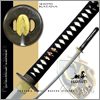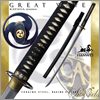| |

Are you looking for a new design motif? Employ the martial arts to make your office or home space stand out from the crowd. An antique or new battle ready katana makes a statement when displayed on walls. With amazing attention to detail, modern swordsmiths have found a balance between brutality and beauty. A hand made katana is a must have for any Eastern weapons collector. Add a few extra details to your collection with a traditional Japanese obi, kimono or even a set of armor and the display area will be like no other.
Center your health with a hand made katana

Are you looking for a new, fun way to stay healthy? Gendai
budo, or modern Japanese martial arts, are great ways
to stay in shape, and there is nothing like the excitement
of learning to use a hand made katana in your practice.
Samurai
swords are beautifully made with as much
attention to the aesthetics as the strength of the sword.
Of course a strong blade is also a must have. We have
katanas for sale from the best sword makers in the world.
Choose from models by Cheness Cutlery, Hanwei by Paul
Chen and Dynasty Forge as well as samurai swords from
Thaitsuki, Masahiro, Musashi and Ryumon.
The katana is characterized by its distinctive
appearance; a curved, slender, single edged blade, circular
or squared guard, and long grip to accommodate two hands.
Historically, it has become inseparable from image of
the samurai of feudal Japan, and has become renowned for
its extraordinary sharpness and cutting ability. Indeed,
in modern popular culture the capabilities of the katana
have far exceeded its real-life limitations.
The katana originated in the Muromachi period (1392–1573),
as a result of changing battle conditions requiring faster
response times. The katana facilitated this by being worn
with the blade facing up, which allowed the samurai to draw
and cut their enemy in a single motion. Previously, the
curved sword of the samurai was worn with the blade facing
down. This sort of response was also increasingly useful
in the daily life of the samurai.
The length of the katana'a blade varied considerably
during the course of its history. In the late 14th and
early 15th centuries, katana blades tended to be between
70 and 73 cm in length. During the early 16th century,
average length was much closer to 60 cm, but late in the
16th century, is again approximately 73 cm
Storage and maintenence
If mishandled in its storage or maintenance, the katana
may become seriously damaged. It is extremely important
that the blade remain well-oiled and polished, as the natural
moisture residue from the hands of the user will rapidly
cause the blade to rust if allowed to remain. When stored
for longer periods, it is likewise important that the katana
be checked frequently and aired out if necessary to prevent
rusting, or mold from forming (which would feed off the
salts in the oil used to polish it).
.Shinken (真剣, Shinken?), literally meaning
"real sword", is a Japanese term used to describe
a Japanese sword that is sharp and used for real cutting
or combat, as opposed to those that are blunted for other
types of practice. Today, they are primarily used for
high level iaido and/or tameshigiri (cutting) practice.
Unlike an iaito or mogito (an unsharpened sword for iaido
practice), a shinken has a sharpened edge. "Gendaito"
are hand-made shinken by one of approximately 250 swordsmiths
active in Japan at the moment, members of the Japanese
Swordsmith Association. These swordsmiths are limited
by Japanese law to producing no more than twenty-four
swords a year each. This limit, along with highly specialised
skills and the need for a great deal of manual labour,
accounts for the high price that a Japanese-made shinken
(Nihonto) can fetch - starting from about $6,000 (US)
for the blade alone, and going many times higher for genuine
antique (Mukansa or Ningen Kokuho are two famous types)
blades.
The tachi was used primarily on horseback, where it was
able to be drawn efficiently for cutting down enemy footsoldiers.
On the ground it was still an effective weapon, but somewhat
awkward to use. This is why its companion, the uchigatana
(the predecessor of the katana) was developed.
It was the predecessor to the katana as the battle-blade
of feudal Japan's bushi (warrior class), and as it evolved
into the later design, the two were often differentiated
from each other only by how they were worn and by the
fittings for the blades.
It was during the Mongol invasions that it was shown
there were some weaknesses in the tachi sword which led
the development of the Katana.
Katanas for sale online
Finding the perfect samurai sword is hard. SwordsOfTheEast.com has made finding swords simple by creating an easy to use online catalog. Browse by price, forge or type of katanas for sale. If you are looking purely for a beautiful piece of steel consider the Musashi or Imperial katana. Do you need a blade to practice martial arts? Swords from the Cold Steel or Hanwei brands are known for durability, strength and beauty. Whatever your needs, we know you'll find a great battle ready katana here. |